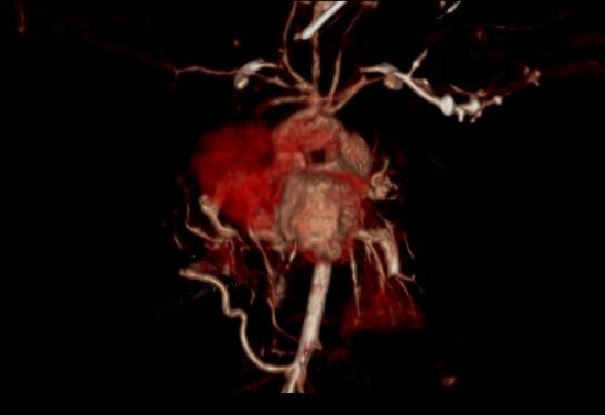Pulmonary sequestration as a cause of persistent pulmonary hypertension in the newborn: a case report.
Main Article Content
Abstract
Background: Persistent pulmonary hypertension of the newborn is a syndrome characterized by acute respiratory failure with hypoxemia caused by a sustained increase in pulmonary vascular resistance, with marked hypoxemia and generalized cyanosis. Pulmonary sequestration is one of the rare causes. Case report: The present case is a neonatal patient without prenatal controls who presented with a picture of respiratory distress dependent on prolonged invasive mechanical ventilation, with suspicion of pneumonia based on the findings in the chest X-ray and CT, without improvement after antibiotic treatment, and with deteriorating cardiorespiratory status. He was assessed by pediatric cardiology and pulmonology, diagnosing the presence of a large patent ductus arteriosus with hemodynamic repercussions and persistent pulmonary hypertension. A chest CT angiography was performed, evidencing intralobar pulmonary sequestration in the right lung and aberrant circulation. It required surgical resection. Conclusions: Persistent pulmonary hypertension is a syndrome with high morbidity and mortality in neonates, so it is necessary to make an early diagnosis, identify the etiology and treat it appropriately based on ventilatory support and vasodilator measures to reduce pulmonary vascular resistance.
Downloads
Article Details

This work is licensed under a Creative Commons Attribution-NonCommercial-NoDerivatives 4.0 International License.
Creative Commons
License Attribution-NonCommercial-ShareAlike 4.0 International (CC BY-NC-SA 4.0)
You are free to:
Share - copy and redistribute the material in any medium or format.
Adapt - remix, transform, and build upon the material The licensor cannot revoke these freedoms as long as you follow the license terms.
• Attribution — You must give appropriate credit, provide a link to the license, and indicate if changes were made. You may do so in any reasonable manner, but not in any way that suggests the licensor endorses you or your use.
• NonCommercial — You may not use the material for commercial purposes.
• ShareAlike — If you remix, transform, or build upon the material, you must distribute your contributions under the same license as the original.
• No additional restrictions — You may not apply legal terms or technological measures that legally restrict others from doing anything the license permits.
References
Alsumrain M, Ryu JH. Pulmonary sequestration in adults: a retrospective review of resected and unresected cases. BMC Pulm Med. 2018;18(1):97. DOI: https://doi.org/10.1186/s12890-018-0663-z
Walker CM, Wu CC, Gilman MD, Godwin JD, Shepard JAO, Abbott GF. The Imaging Spectrum of Bronchopulmonary Sequestration. Curr Probl Diagn Radiol. 2014;43(3):100–14. DOI: https://doi.org/10.1067/j.cpradiol.2014.01.005
Petersen G, Martin U, Singhal A, Criner GJ. Intralobar sequestration in the middle-aged and elderly adult: recognition and radiographic evaluation. J Thorac Cardiovasc Surg. 2003;126(6):2086–90. DOI: https://doi.org/10.1016/S0022-5223(03)01297-2
Wei Y, Li F. Pulmonary sequestration: a retrospective analysis of 2625 cases in China. European Journal of Cardio-Thoracic Surgery. 2011;40(1):e39–42. DOI: https://doi.org/10.1016/j.ejcts.2011.01.080
Lakshminrusimha S, Keszler M. Persistent Pulmonary Hypertension of the Newborn. Neoreviews. 2015;16(12):e680 LP-e692. DOI: https://doi.org/10.1542/neo.16-12-e680
Arias D, Narváez C. Atención al recién nacido con hipertensión pulmonar persistente. Repertorio de Medicina y Cirugía. 2016;25(4):219–27. DOI: https://doi.org/10.1016/j.reper.2016.10.008
Méndez L, Osorio O, Contreras M, García Del villar O, Vence C, Barrios K. Secuestro pulmonar una infrecuente causa de hipertensión pulmonar persistente en el recién nacido reporte de un caso. Salud Uninorte. 2017;33(3):532–7. DOI: https://doi.org/10.14482/sun.33.3.10921
Jain A, McNamara PJ. Persistent pulmonary hypertension of the newborn: Advances in diagnosis and treatment. Semin Fetal Neonatal Med. 2015;20(4):262–71. DOI: https://doi.org/10.1016/j.siny.2015.03.001
Savic B, Birtel FJ, Tholen W, Funke HD, Knoche R. Lung sequestration: report of seven cases and review of 540 published cases. Thorax. 1979;34(1):96–101. DOI: https://doi.org/10.1136/thx.34.1.96
Salinas JA. Patología pulmonar congénita: Evaluación y manejo perinatal. Revista Médica Clínica Las Condes. 2016;27(4):485–98. DOI: https://doi.org/10.1016/j.rmclc.2016.07.008
Laberge JM, Puligandla P, Flageole H. Asymptomatic congenital lung malformations. Semin Pediatr Surg. 2005;14(1):16–33. DOI: https://doi.org/10.1053/j.sempedsurg.2004.10.022
Curros F, Chigot V, Emond S, Sayegh N, Revillon Y, Scheinmann P, et al. Role of embolisation in the treatment of bronchopulmonary sequestration. Pediatr Radiol [Internet]. 2000;30(11):769–73. DOI: https://doi.org/10.1007/s002470000332
Marine LM, Valdes FE, Mertens RM, Bergoeing MR, Kramer A. Endovascular Treatment of Symptomatic Pulmonary Sequestration. Ann Vasc Surg. 2011;25(5):696.e11-696.e15. DOI: https://doi.org/10.1016/j.avsg.2010.08.012





